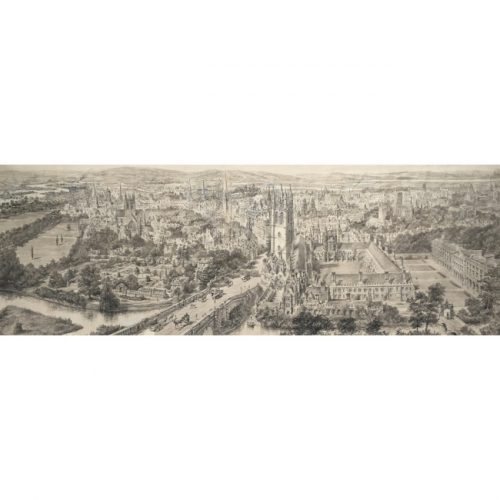-
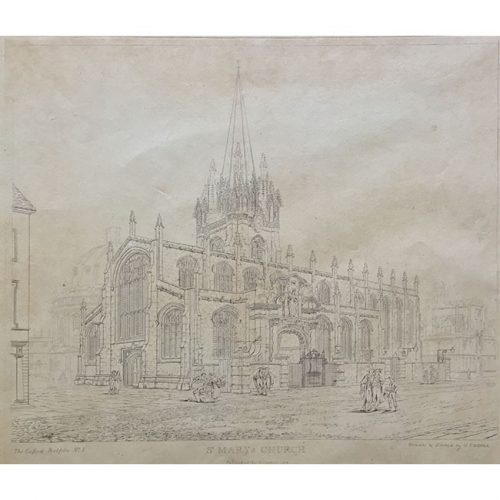
G. Cooper
St. Mary's Church, Oxford
Etching c. 1820 40x47cm From The Oxford Portfolio a series of thirteen views printed on Sepia paper, very rare. If you are interested email info@manningfineart.co.uk or call us on 07929 749056. -
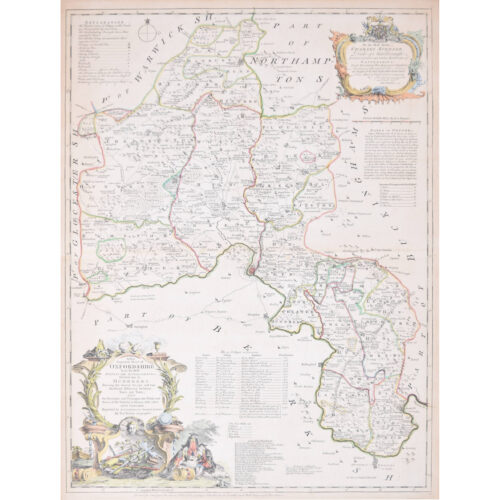
Thomas Kitchin (1719 - 1784)
Map of Oxfordshire (1764)
Engraving with later hand-colouring 72 x 54 cm This decorative map of Oxfordshire features a cartouche with three concentrating scholars and various educational trappings like rolls of parchment. The cartouche in the upper right corner dedicates the map to Charles Spencer, Duke of Marlborough, whose family seat of Blenheim Palace is just outside the city of Oxford. The map also sports a list of the University of Oxford's colleges, its rectories and vicarages, and a paragraph on the Earls of Oxford. Thomas Kitchin was an English engraver and cartographer. He was born in London and was apprenticed to the map engraver Emanuel Bowen in 1732. He produced John Elphinstone's map of Scotland (1746), the Geographia Scotiae (1749), and The Small English Atlas (1749) with Thomas Jefferys. Kitchen worked for the London Magazine and for the King; there is also some debate as to whether he passed off other cartographers' work as his own. Condition: generally very good; central fold as issued, another fold to middle of top half, three tiny losses (a millimetre or two) just outside plate mark to left side. If you are interested, please email info@manningfineart.co.uk or call us on 07929 749056. Click here for other decorative maps. -
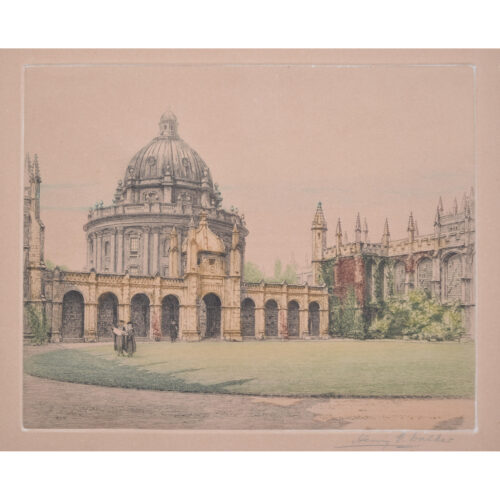
Henry George Walker (1876 - 1932)
The Radcliffe Camera from All Souls College, Oxford
Etching 20 x 25 cm Signed lower right in pencil. The artist depicts the North Quadrangle of All Souls, with the Radcliffe Camera peeking in. Two fellows contemplate a document as a third approaches. Henry Walker was born in Birmingham and specialised in architectural and landscape etchings. Condition: generally very good. If you’d like to know more, please email info@manningfineart.co.uk or call us on 07929 749056. Click here for other views of All Souls. -
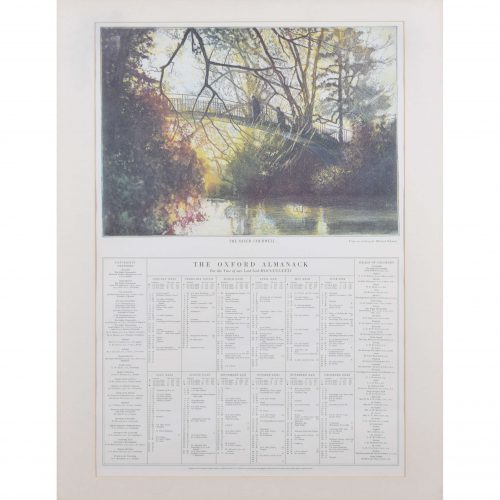
after Michael Oelman (born 1941)
The River Cherwell, The Oxford Almanac 1981
Lithograph 71 x 47 cm A lithograph featuring Oxford's wondrous River Cherwell in University Parks, after an etching by Michael Oelman. A setting sun casts its gold light over the glassy surface of the river and its surrounding trees; two figures cross the Cherwell via the famous Rainbow Bridge. The curved footbridge was built in the early 1920s by the University a project for the unemployed. Oelman's etching was reproduced as a lithograph in 1981, to be published in the "Oxford Almanack". The Oxford Almanack was an annual almanac published by the Oxford University Press for the University of Oxford from 1674 through 2019 (when printing sadly ceased due to "dwindling interest"). The almanac traditionally included engravings or lithographs of the University and information about the upcoming year. Other almanac artists have included James Basire, Michael Burghers, J. M. W. Turner, and John Piper. Michael Oelman was born in Llandudno, Wales, in 1941. He studied fine art at Reading University and then etching and lithography at the Central and Slade Schools of Art. In the 1960s he studied with S. W. Hayter in Paris, and then became a lecturer in Printmaking at Doncaster College of Art, Yorkshire. His studio is in Suffolk. Condition: very good. If you are interested, please email info@manningfineart.co.uk or call us on 07929 749056. Click here for other general views of Oxford. -
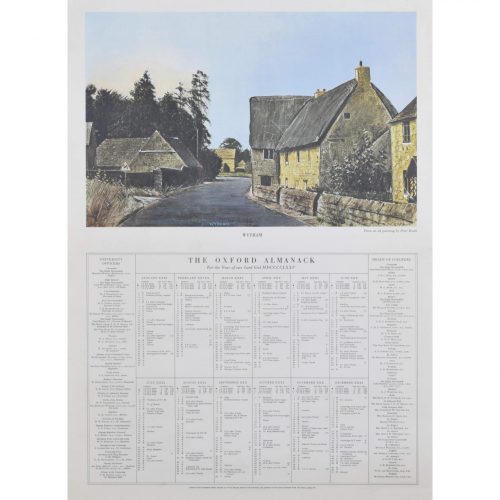
after Peter Brook (1927 - 2009)
Wytham - Oxford Almanack 1975
Lithograph 70 x 48 cm A lithograph of Wytham, a characterful and historic village north-west of Oxford. The original painting hangs in the Ashmolean Museum. Brook's painting was reproduced as a lithograph in 1975 to be published in the "Oxford Almanack". The Oxford Almanack was an annual almanack published by the Oxford University Press for the University of Oxford from 1674 through 2019 (when printing sadly ceased due to "dwindling interest"). The almanack traditionally included engravings or lithographs of the University and information about the upcoming year. Other almanack artists have included James Basire, Michael Burghers, J. M. W. Turner, and Michael Oelman. Peter Brook RBA was an English artist best known for his landscape paintings; he was nicknamed "The Pennine Landscape Painter". He was elected to the Royal Society of British Artists in 1962. Condition: very good. If you are interested, please email info@manningfineart.co.uk or call us on 07929 749056. Click here for other general views of Oxford. -
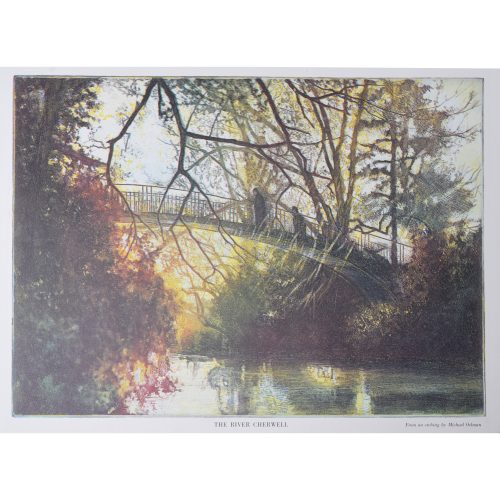
Michael Oelman (born 1941)
The River Cherwell
Lithograph 33 x 46 cm A lithograph of Oxford's wondrous River Cherwell in University Parks, from an etching by Michael Oelman. A setting sun casts its gold light over the glassy surface of the river and its surrounding trees; two figures cross the Cherwell via the famous Rainbow Bridge. The curved footbridge was built in the early 1920s by the University a project for the unemployed. Oelman's etching was reproduced as a lithograph in 1981, to be published in the "Oxford Almanack". The Oxford Almanack was an annual almanac published by the Oxford University Press for the University of Oxford from 1674 through 2019 (when printing sadly ceased due to "dwindling interest"). The almanac traditionally included engravings or lithographs of the University and information about the upcoming year. Other almanac artists have included James Basire, Michael Burghers, J. M. W. Turner, and John Piper. Michael Oelman was born in Llandudno, Wales, in 1941. He studied fine art at Reading University and then etching and lithography at the Central and Slade Schools of Art. In the 1960s he studied with S. W. Hayter in Paris, and then became a lecturer in Printmaking at Doncaster College of Art, Yorkshire. His studio is in Suffolk. Condition: very good. If you’d like to know more, please email info@manningfineart.co.uk or call us on 07929 749056. -
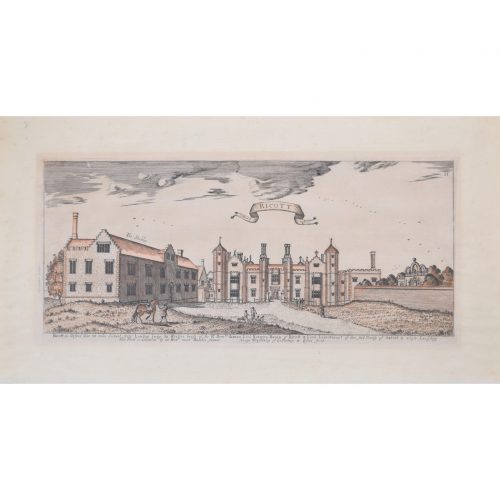
Henry Winstanley (1644 - 1703)
Rycote House, Oxfordshire
Engraving 19 x 44 cm Rycote House, Oxfordshire, was a Tudor (and later Georgian) country house. The house was built in the 16th century, and in 1920, after a period of decline, the extensive stables were converted into the present Rycote House. Condition: generally very good; some age toning. If you are interested, please email info@manningfineart.co.uk or call us on 07929 749056. Click here for other architectural drawings. -

after Edward Dayes (1763 - 1804)
Oxford (1792)
Hand-coloured engraving 15 x 20 cm Published February 1st 1792 by Harrison & Co, Paternoster Row. A charmingly-coloured Oxford punting scene, with Magdalen Tower and other dreaming spires behind. Edward Dayes was an English watercolour painter and mezzotint engraver. He first exhibited at the Royal Academy in 1786, when he showed a portrait and views of Waltham Cross and Canterbury. In the three following years he exhibited both miniatures and landscapes. He continued to exhibit at the Academy regularly until the year of his death, contributing a total of 64 works. He also exhibited at the Society of Artists, and worked as draughtsman to the Duke of York and Albany. Condition: very good. If you’d like to know more, please email info@manningfineart.co.uk or call us on 07929 749056. Click here for other general views of Oxford. -
Out of stock
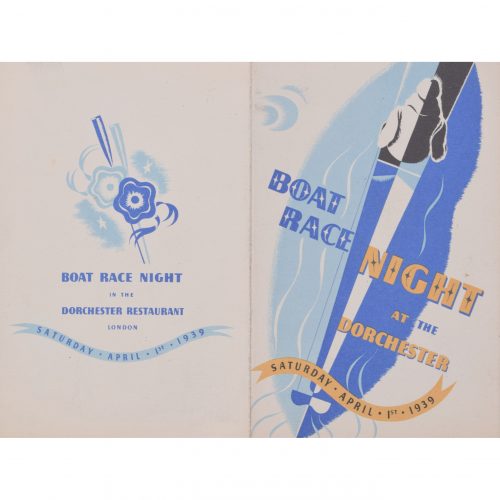
Brownbridge (flourished 1930s - 1940s)
Boat Race at the Dorchester (1939)
Lithographic brochure 15 x 19.5 cm From a small archive of works by Brownbridge, a member of the Society of Industrial Artists. A design for a poster advertising the Dorchester's dinner after the Oxford and Cambridge Boat Race. The artist has built his design around dark and light blues, to represent the colours of Oxford and Cambridge respectively. Brownbridge's design is marvellously 1930s, from the boldly decorative typeface to the whimsically glamorous guests and their waiters floating below the invitation. Boat Race dinners in London are rather different today; at any rate, prices are not normally advertised as 'excluding Wines and Cigars'. Society of Industrial Artists correspondance (photographed above) is not included; please enquire separately. Condition: generally very good. If you are interested, please email info@manningfineart.co.uk or call us on 07929 749056. Click here for other designs by Brownbridge. -
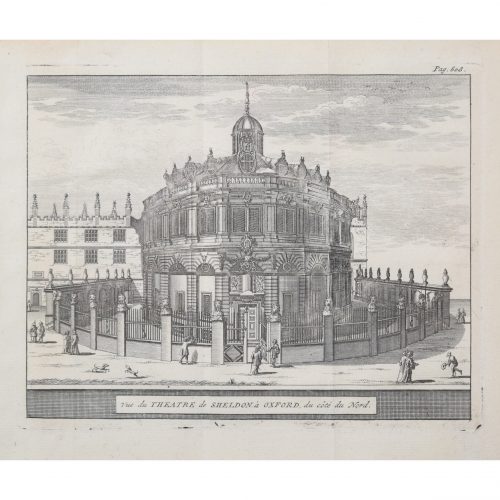
Pieter van der Aa (1659-1733), after David Loggan (1634–1692)
The Sheldonian Theatre, University of Oxford (1727)
Engraving 12 x 16 cm An eighteenth-century view of Oxford's marvellous Sheldonian Theatre, engraved by Pieter van der Aa after David Loggan, the noted engraver, draughtsman, and painter. Christopher Wren designed the building and it was constructed between 1664 and 1669; it takes its name from Gilbert Sheldon, chancellor of the University at the time and the Theatre's main financial backer. Pieter van der Aa of Leiden was a Dutch publisher best known for preparing maps and atlases, though he also printed editions of foreign bestsellers and illustrated volumes. He is noted for the many engravings he produced after David Loggan's series of Oxford and Cambridge colleges and costumes. In 1727 Van Der Aa illustrated "Les Delices de la Grande Bretagne & de L'Irelande" by James Beeverell, the book in which this engraving appears. Condition: a good impression. If you’d like to know more, please email info@manningfineart.co.uk or call us on 07929 749056. -
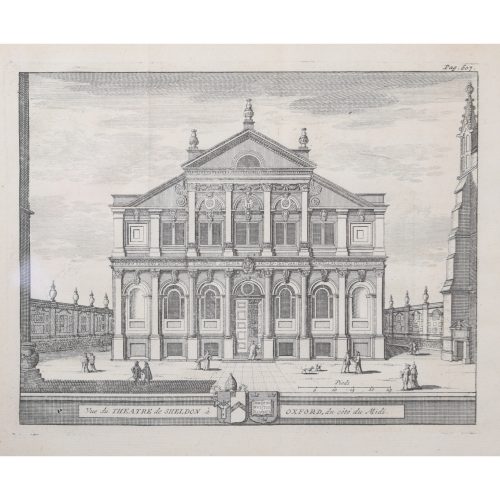
Pieter van der Aa (1659-1733), after David Loggan (1634–1692)
The Sheldonian Theatre, University of Oxford (1727)
Engraving 12 x 16 cm An eighteenth-century view of Oxford's marvellous Sheldonian Theatre, engraved by Pieter van der Aa after David Loggan, the noted engraver, draughtsman, and painter. Christopher Wren designed the building and it was constructed between 1664 and 1669; it takes its name from Gilbert Sheldon, chancellor of the University at the time and the Theatre's main financial backer. Pieter van der Aa of Leiden was a Dutch publisher best known for preparing maps and atlases, though he also printed editions of foreign bestsellers and illustrated volumes. He is noted for the many engravings he produced after David Loggan's series of Oxford and Cambridge colleges and costumes. In 1727 Van Der Aa illustrated "Les Delices de la Grande Bretagne & de L'Irelande" by James Beeverell, the book in which this engraving appears. Condition: a good impression. If you’d like to know more, please email info@manningfineart.co.uk or call us on 07929 749056. -
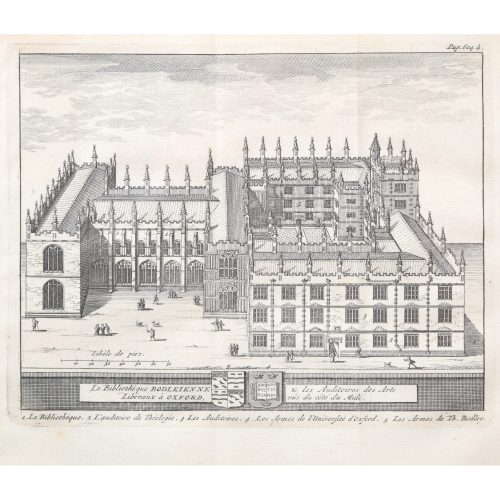
Pieter van der Aa (1659-1733), after David Loggan (1634–1692)
The Bodleian Library, Oxford (1727)
Engraving 12 x 16 cm An eighteenth-century view of the beautiful Bodleian Library, engraved by Pieter van der Aa after David Loggan, the noted engraver, draughtsman, and painter. Pieter van der Aa of Leiden was a Dutch publisher best known for preparing maps and atlases, though he also printed editions of foreign bestsellers and illustrated volumes. He is noted for the many engravings he produced after David Loggan's series of Oxford and Cambridge colleges and costumes. In 1727 Van Der Aa illustrated "Les Delices de la Grande Bretagne & de L'Irelande" by James Beeverell, the book in which this engraving appears. Condition: a good impression. If you’d like to know more, please email info@manningfineart.co.uk or call us on 07929 749056. -
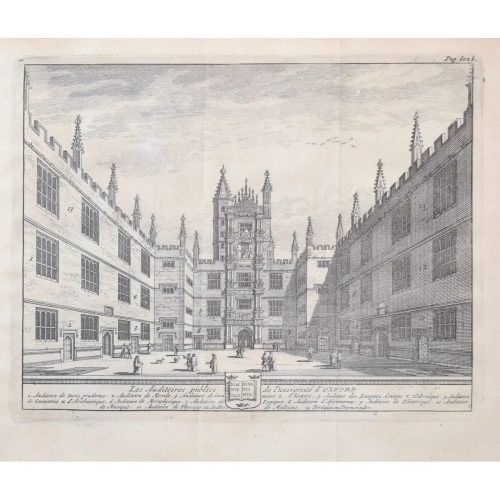
Pieter van der Aa (1659-1733), after David Loggan (1634–1692)
The Public Schools, University of Oxford (1727)
Engraving 12 x 16 cm An eighteenth-century view of the interior of the Public Schools, engraved by Pieter van der Aa after David Loggan, the noted engraver, draughtsman, and painter. Pieter van der Aa of Leiden was a Dutch publisher best known for preparing maps and atlases, though he also printed editions of foreign bestsellers and illustrated volumes. He is noted for the many engravings he produced after David Loggan's series of Oxford and Cambridge colleges and costumes. In 1727 Van Der Aa illustrated "Les Delices de la Grande Bretagne & de L'Irelande" by James Beeverell, the book in which this engraving appears. Condition: a good impression. If you’d like to know more, please email info@manningfineart.co.uk or call us on 07929 749056. -
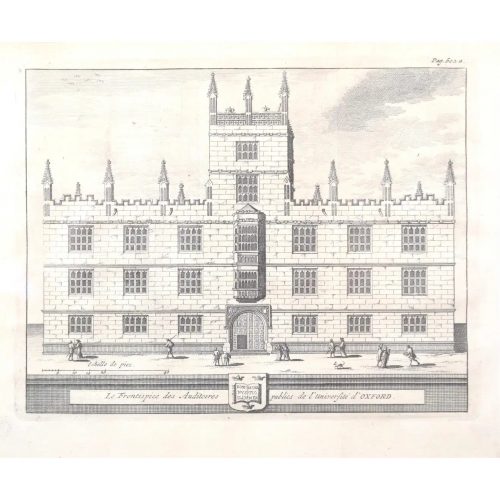
Pieter van der Aa (1659-1733), after David Loggan (1634–1692)
The Public Schools, University of Oxford (1727)
Engraving 12 x 16 cm An eighteenth-century view of the facade of Oxford's Public Schools, engraved by Pieter van der Aa after David Loggan, the noted engraver, draughtsman, and painter. Pieter van der Aa of Leiden was a Dutch publisher best known for preparing maps and atlases, though he also printed editions of foreign bestsellers and illustrated volumes. He is noted for the many engravings he produced after David Loggan's series of Oxford and Cambridge colleges and costumes. In 1727 Van Der Aa illustrated "Les Delices de la Grande Bretagne & de L'Irelande" by James Beeverell, the book in which this engraving appears. Condition: a good impression. If you’d like to know more, please email info@manningfineart.co.uk or call us on 07929 749056. -
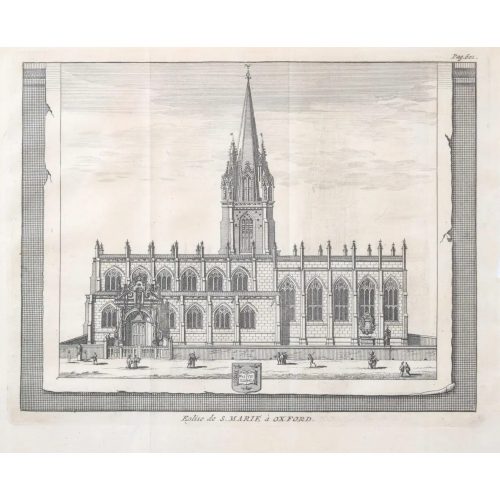
Pieter van der Aa (1659-1733), after David Loggan (1634–1692)
The University Church of St Mary the Virgin, University of Oxford (1727)
Engraving 12 x 16 cm An eighteenth-century view of the University Church, engraved by Pieter van der Aa after David Loggan, the noted engraver, draughtsman, and painter. St Mary's was the first building of the University of Oxford and its parish consists almost exclusively of university and college buildings. Its eccentric Baroque porch, designed by Nicholas Stone, faces the High Street, and it boasts a spire which is claimed by some church historians to be one of the most beautiful in England. Radcliffe Square lies to the north and to the east is Catte Street. The 13th-century tower is open to the public and provides magnificent views across the heart of the historic university city, especially Radcliffe Square, the Radcliffe Camera, Brasenose College, and All Souls College. Of particular interest here is the trompe l'oeil piece of gently torn paper which frames the view of the church. Pieter van der Aa of Leiden was a Dutch publisher best known for preparing maps and atlases, though he also printed editions of foreign bestsellers and illustrated volumes. He is noted for the many engravings he produced after David Loggan's series of Oxford and Cambridge colleges and costumes. In 1727 Van Der Aa illustrated "Les Delices de la Grande Bretagne & de L'Irelande" by James Beeverell, the book in which this engraving appears. Condition: a good impression. If you’d like to know more, please email info@manningfineart.co.uk or call us on 07929 749056. -
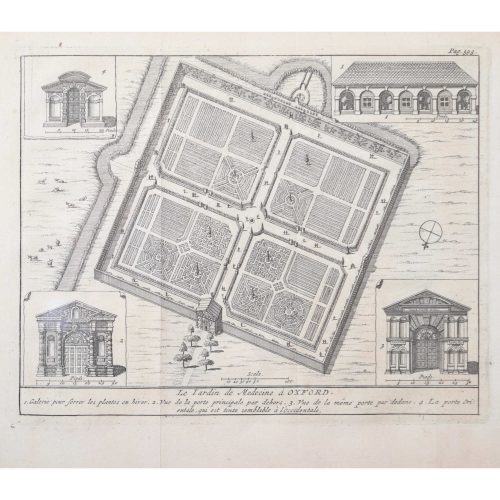
Pieter van der Aa (1659-1733), after David Loggan (1634–1692)
The University of Oxford Botanic Garden (1727)
Engraving 12 x 16 cm An eighteenth-century view of one of Oxford's dreamiest spaces: the Botanic Garden, engraved by Pieter van der Aa after David Loggan, the noted engraver, draughtsman, and painter. The University of Oxford Botanic Garden was founded in 1621 and is the oldest botanical garden in Great Britain. van der Aa's engraving focuses on its architectural qualities, with four features of the garden highlighted for their beauty, symmetry, and prowess of design. Of particular interest in this etching are the four trompe l'oeil pieces of gently curling paper which frame the gates of the garden. The Danby Gate (bottom left) at the front entrance to the garden is one of the three entrances designed by Nicholas Stone between 1632 and 1633. The gateway consists of three bays, each with a pediment; the niches contain statues of Charles I and Charles II in classical pose, and the niche in the the central pediment contains a bust of the Earl of Danby (hence the gate's name). Pieter van der Aa of Leiden was a Dutch publisher best known for preparing maps and atlases, though he also printed editions of foreign bestsellers and illustrated volumes. He is noted for the many engravings he produced after David Loggan's series of Oxford and Cambridge colleges and costumes. In 1727 Van Der Aa illustrated "Les Delices de la Grande Bretagne & de L'Irelande" by James Beeverell, the book in which this engraving appears. Condition: a good impression. If you’d like to know more, please email info@manningfineart.co.uk or call us on 07929 749056. -

Pieter van der Aa (1659-1733), after David Loggan (1634–1692)
Oxford from the East (1727)
Engraving 12 x 16 cm An eighteenth-century view of Oxford from the east, engraved by Pieter van der Aa after David Loggan, the noted engraver, draughtsman, and painter. The skies are wide and full of the University's dreaming spires. Pieter van der Aa of Leiden was a Dutch publisher best known for preparing maps and atlases, though he also printed editions of foreign bestsellers and illustrated volumes. He is noted for the many engravings he produced after David Loggan's series of Oxford and Cambridge colleges and costumes. In 1727 Van Der Aa illustrated "Les Delices de la Grande Bretagne & de L'Irelande" by James Beeverell, the book in which this engraving appears. Condition: a good impression. If you’d like to know more, please email info@manningfineart.co.uk or call us on 07929 749056. -
Out of stock
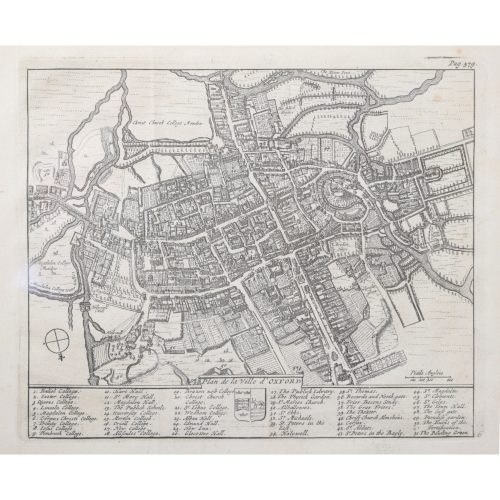
Pieter van der Aa (1659-1733), after David Loggan (1634–1692)
Map of Oxford (1727)
Engraving 12 x 16 cm An eighteenth-century map of Oxford, engraved by Pieter van der Aa after David Loggan, the noted engraver, draughtsman, and painter. The aerial view shows the city and its university buildings in all their glory. Pieter van der Aa of Leiden was a Dutch publisher best known for preparing maps and atlases, though he also printed editions of foreign bestsellers and illustrated volumes. He is noted for the many engravings he produced after David Loggan's series of Oxford and Cambridge colleges and costumes. In 1727 Van Der Aa illustrated "Les Delices de la Grande Bretagne & de L'Irelande" by James Beeverell, the book in which this engraving appears. Condition: a good impression. If you’d like to know more, please email info@manningfineart.co.uk or call us on 07929 749056. -

Sir Hugh Casson (1910-1999)
Magdalen Bridge Oxford
Lithographic print unsigned. Provenance: the artist’s estate. 28 x 35 cm (11 x 14 in) From Casson’s ever-popular Oxford series of prints. If you are interested email info@manningfineart.co.uk or call us on 07929 749056. For biographical details and other works by the artist click here. -
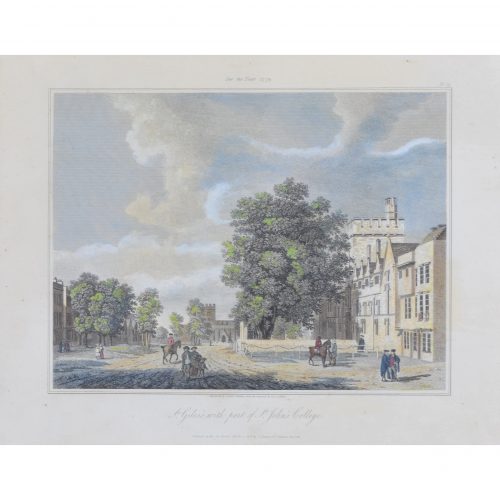
Joseph Constantine Stadler (1755 - 1828) after Michael Angelo Rooker (1743/6 - 1801)
St Giles's with a part of St John's College (1813)
Engraving with later hand-colouring 25 x 32 cm An engraving of St Giles, including the famous St Giles Church, with the front of St John's to the right. Joseph Constantine Stadler was a prolific German émigré engraver of images after his contemporaries. Stadler's engravings are wide-ranging in subject matter and include landscapes, seascapes and portraits, as well as military, sporting and decorative subjects. Stadler was employed by the leading print publisher of the time, John Boydell. Stadler lived in Knightsbridge when he died at the age of 73. Michael Angelo Rooker ARA was an English oil and watercolour painter of architecture and landscapes, illustrator, and engraver. Condition: good. Some gentle age toning. If you are interested, please email info@manningfineart.co.uk or call us on 07929 749056. Click here for other views of St John’s College, Oxford. -
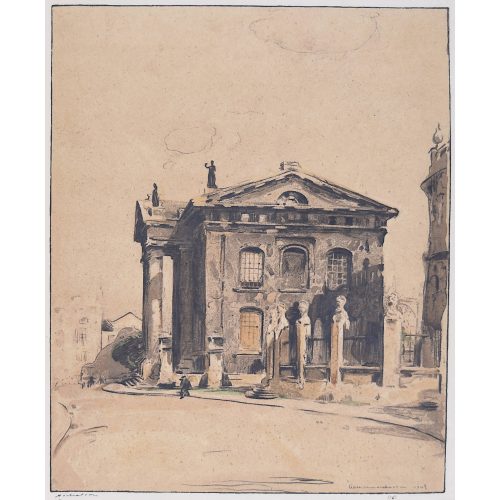
William Nicholson (1872-1949)
Clarendon Building Oxford (1906)
Lithograph, signed lower left, with Stafford Gallery blindstamp 32 x 26cm Click here for biography and other works by this artist. If you are interested email info@manningfineart.co.uk or call us on 07929 749056. -
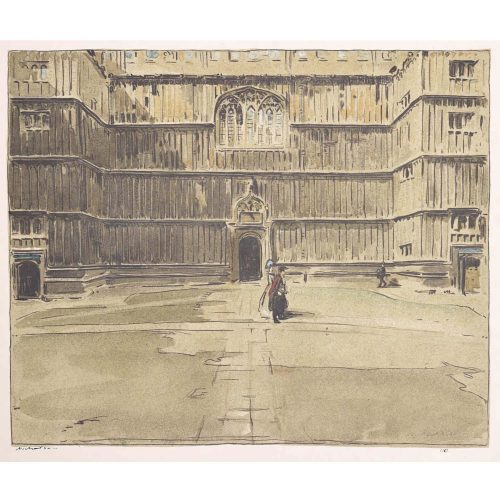
William Nicholson (1872-1949) Bodleian Library, University of Oxford
Signed and numbered 110, published by Stafford Gallery with blind stamp Lithograph 28 x 34.5cm Click here for biography and other works by this artist. If you are interested email info@manningfineart.co.uk or call us on 07929 749056. Condition: Generally very good condition. -

after Michael Angelo Rooker (1743/6 - 1801)
North West view of Friar Bacon's Study, and Folly Bridge
Engraving 30 x 45 cm Friar Bacon's Study was built as a watchtower in the thirteenth century. The name is 'merely traditional, and not in any Record to be found', according to the 1773 text 'The Antient and Present State of the City of Oxford'; it is said to have been used by the Franciscan Friar Roger Bacon as an astronomical observatory. For hundreds of years after Friar Bacon's use of it, the tower was a notable landmark in Oxford, and Samuel Pepys visited it in 1668: 'So to Friar Bacon's study: I up and saw it, and gave the man a shilling. Oxford mighty fine place.' The Study was often considered a folly, and the bridge is now known as Folly Bridge. Rooker painted the tower in 1780 - around the same time as the tower was demolished - and James Basire produced an engraving of his painting in 1787, to be used as the frontispiece for the Oxford Almanack. The Oxford Almanack was an annual almanack published by the Oxford University Press for the University of Oxford from 1674 through 2019 (when printing sadly ceased due to "dwindling interest"). The almanack traditionally included engravings or lithographs of the University and information about the upcoming year. Other almanack artists have included Michael Burghers, J. M. W. Turner, and John Piper. Basire and Dayes collaborated on several views of Oxford during the courses of their careers. Michael Angelo Rooker ARA was an English oil and watercolour painter of architecture and landscapes, illustrator, and engraver. Rooker's original painting currently hangs in Worcester College. Condition: good; in handsome (worn) antique Hogarth frame. If you are interested, please email info@manningfineart.co.uk or call us on 07929 749056. Click here for other non-collegiate views of Oxford. -
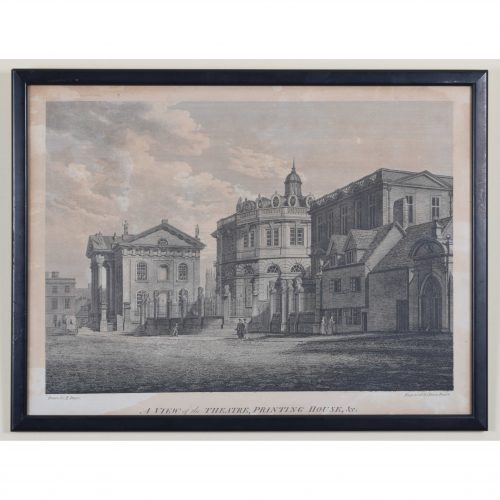
James Basire II (1769 - 1822) after Edward Dayes (1763 - 1804)
A View of the Theatre, Printing House, & c. (1800)
Engraving 36 x 49 cm A view of Broad Street, showing the Clarendon Building, Sheldonian Theatre, and what is now the Museum of the History of Science. Edward Dayes' drawing was reproduced as a lithograph in 1800, to be published in the "Oxford Almanack". The Oxford Almanack was an annual almanack published by the Oxford University Press for the University of Oxford from 1674 through 2019 (when printing sadly ceased due to "dwindling interest"). The almanack traditionally included engravings or lithographs of the University and information about the upcoming year. Other almanack artists have included Michael Burghers, J. M. W. Turner, and John Piper. Basire and Dayes collaborated on several views of Oxford during the courses of their careers. Edward Dayes was a British painter and engraver. He exhibited topographical views at the Royal Academy from 1786 until his death, and is the author of an ''Excursion through Derbyshire and Yorkshire,'' ''Essays on Painting; Instructions for Drawing and Colouring Landscapes'', and ''Professional Sketches of Modem Artists''. James Basire II was a British engraver, son of James Basire I, also a celebrated engraver. In 1802 he became Engraver to the Society of Antiquaries. Condition: some browning, as visible in photograph. If you’d like to know more, please email info@manningfineart.co.uk or call us on 07929 749056. -

Brendan Neiland (b. 1941) R.A. (Expelled)
Cherwell Bridge
Screenprint 53 x 34 cm Signed, titled, and numbered 43 / 175 in pencil. A screenprint of Oxford’s beauteous Cherwell Bridge in University Parks, reflected in the glassy surface of the river. Reflected architecture is one of Neiland’s most recurring themes. Neiland's work is widely exhibited in major museums and galleries worldwide including, in Britain, the Victoria and Albert Museum, The Tate Gallery London, The Collections of the British Council, and the Arts Council of Great Britain. He is represented by the Redfern Gallery and has had numerous shows internationally, including at the Galerie Belvedere in Singapore, who represent him in Singapore and the Far East. Condition: very good. If you’d like to know more, please email info@manningfineart.co.uk or call us on 07929 749056. -
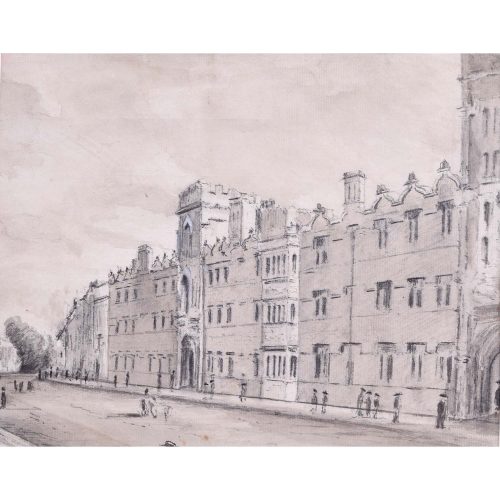
Anonymous
Oxford High Street (c.1840)
Pencil & wash on paper 18x23cm If you are interested email info@manningfineart.co.ukor call us on 07929 749056. Condition: Good. -
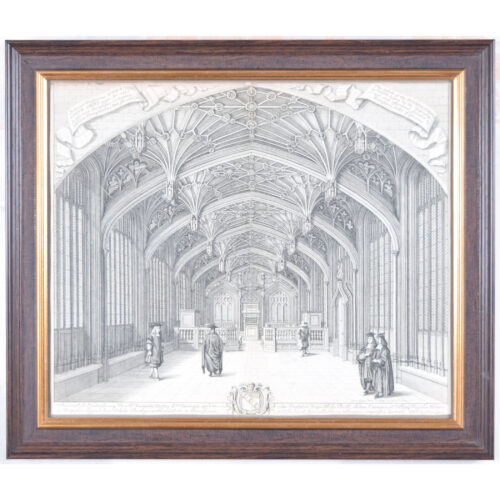
David Loggan (1634 - 1692)
The Divinity School, Oxford (1675)
Engraving 33 x 41 cm David Loggan's view of Oxford's medieval Divinity School, which was once the beating heart of theological studies at the University. Of particular interest here is the trompe l'oeil scroll of torn paper which frames the view. Loggan was born to English and Scottish parents, and was baptised in Danzig in 1634. After studying engraving in Danzig with Willem Hondius (1598-1652 or 1658), he moved to London in the late 1650s, going on to produce the engraved title-page for the folio 1662 Book of Common Prayer. He married in 1663 and moved to Nuffield in Oxfordshire in 1665. Loggan was appointed Public Sculptor to the nearby University of Oxford in the late 1660s, having been commissioned to produce bird’s-eye views of all the Oxford colleges. He lived in Holywell Street as he did this. The 'Oxonia Illustrata' was published in 1675, with the help of Robert White (1645-1704). Following its completion, Loggan began work on his equivalent work for Cambridge; the 'Cantabrigia Illustrata' was finally published in 1690, when he was made engraver to Cambridge University. The 'Oxonia Illustrata' also includes an engraving of Winchester College (Winchester and New College share William of Wykeham as their founder) whilst the 'Cantabrigia Illustrata' includes one of Eton College (which shares its founder, Henry VIII, with King’s College). Bird’s-eye views from this era required a particular talent as an architectural perspectivist; it was not until 1783 that it became possible for artists to ascend via hot air balloons and view the scenes they were depicting from above. Loggan thus had to rely on his imagination in conceiving the views. Loggan’s views constitute the first accurate depictions of the two Universities, in many ways unchanged today. Whilst the Oxford engravings were produced in reasonable numbers and ran to a second edition by Henry Overton (on thicker paper and with a plate number in Roman numerals in the bottom right-hand corner), those of Cambridge were printed in much smaller numbers. The Dutchman Pieter van der Aa published some miniature versions of the engravings for James Beverell’s guidebook to the UK, 'Les Delices de la Grande Bretagne' (circa 1708). The contemporary artist Andrew Ingamells (born 1956) has produced a highly-acclaimed series of etchings which bring Loggan’s original vision up to date. Condition: trimmed within platemark and mounted to board, otherwise in very good condition. If you are interested, please email info@manningfineart.co.uk or call us on 07929 749056. Click here for other general views of Oxford. -
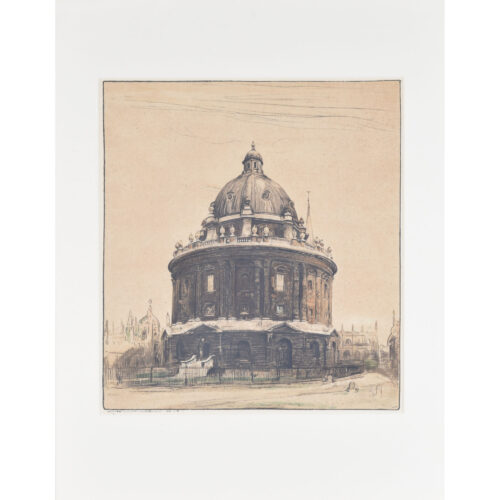
William Nicholson (1872 - 1949)
The Radcliffe Camera, Oxford
Lithograph 35 x 28 cm Signed lower left and numbered 10 in ink. Between 1902 and 1904 William Nicholson lived in Woodstock; during this period he made several architectural studies of Oxford's colleges and other University buildings. Sir William Nicholson was a British painter and printmaker. He is also known as an illustrator, author of children’s books, stained glass designer, and theatre set designer. Condition: very good. If you are interested, please email info@manningfineart.co.uk or call us on 07929 749056. Click here for other general views of Oxford. -
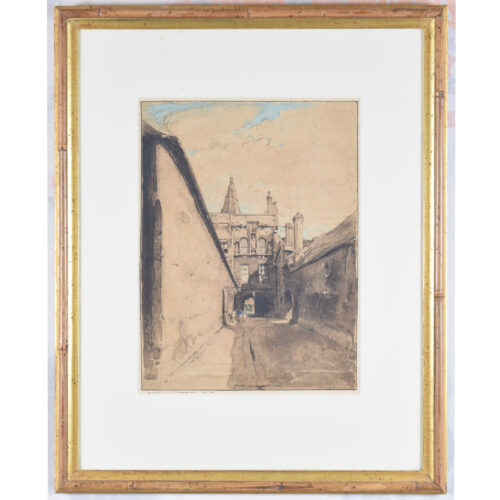
William Nicholson (1872 - 1949)
New College Lane, Oxford
Lithograph 35 x 28 cm Signed lower left and numbered 10 in ink. Between 1902 and 1904 William Nicholson lived in Woodstock; during this period he made several architectural studies of Oxford's colleges and other University buildings. Sir William Nicholson was a British painter and printmaker. He is also known as an illustrator, author of children’s books, stained glass designer, and theatre set designer. Condition: very good. If you are interested, please email info@manningfineart.co.uk or call us on 07929 749056. Click here for other pictures of New College, Oxford. -
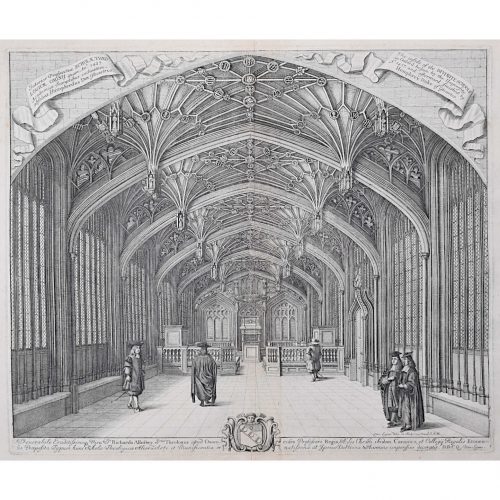
David Loggan (1634-1692)
Scholae Theologicae Oxford
Engraving (1675) 34x41cm To view biographical details and other prints by Loggan click here. Condition: Generally good condition, short edge tears and staining to margins outside platemark. If you are interested email info@manningfineart.co.uk or call us on 07929 749056. -
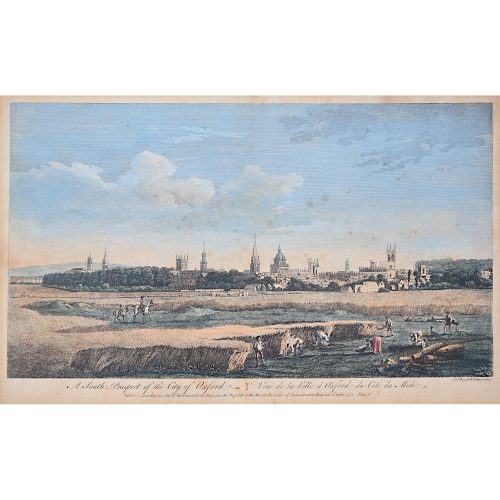
John Boydell (1719-1804)
A South Prospect of the City of Oxford
Hand-coloured engraving published 1751 in the series Four Views of Oxford 28x44.5cm If you are interested email info@manningfineart.co.uk or call us on 07929 749056. One of the most influential Georgian printsellers, Boydell was apprenticed to William Henry Toms at the age of 21, studying drawing at the St Marin's Lane Academy. From 1755 he imported foreign prints in great numbers. He became Mayor of London in 1790. -
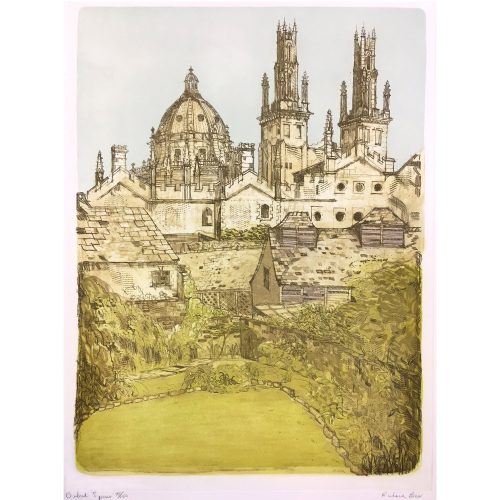
Richard Beer (1928-2017) Oxford Spires - All Souls College and Radcliffe Camera
Limited edition coloured etching signed in pencil and numbered 75/150. 62x44cm Born in London in 1928, just too late to serve in World War II, Richard Beer studied between 1945-1950 at the Slade School. Subsequently, a French Government scholarship allowed him to spend time in Paris at Atelier 17, working under Stanley William Hayter (1901-1988), one of the most significant print makers of the 20th Century – having spent the War in New York, advising as a camofleur, Hayter only returned to Paris in 1950. Subsequently Beer studied at the École des Beaux Arts, Paris. Working for John Cranko, choreographer for the Royal Ballet, Beer designed the sets and costumes for his The Lady and the Fool at Covent Garden, subsequently working for him following his move in 1961 to Stuttgart Ballet. Additionally he produced book illustrations and designed book jackets. Richard Beer taught print-making at the Chelsea School of Art where he was a popular teacher. Probably his greatest work was a collaboration with John Betjeman to produce a portfolio of prints of ten Wren Churches in the City for Editions Alecto, copies of which are in The Government Art Collection. That collection contains a total of 54 prints by Beer, and the Tate Gallery’s collection holds seven. His Oxford series was also produced for Editions Alecto, as was a series of predominantly architectural views in Southern Europe. Most of his prints are of architectural subjects, where he explores the use of colour in interesting fashion. If you are interested email info@manningfineart.co.uk or call us on 07929 749056. Condition: Excellent. -
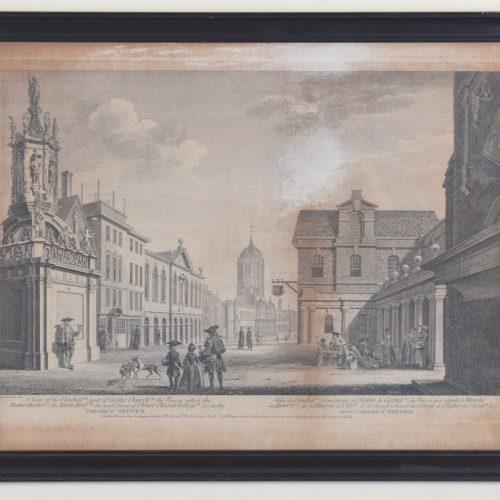
John Donowell (flourished 1753 - 1786) A View of the Conduit part of Carfax Church, the Piazza called the Butter Market, the Town Hall, the West Front of Christ Church College, &c. in the University of Oxford (1750)
Engraving 29 x 42 cm An eighteenth century view of St Aldate''s, featuring the west front of Christ Church and the Town Hall. Undergraduates, academics, and townspeople saunter along, all under the watchful eye of Tom Tower. John Donowell was an eighteenth-century British architect and engraver, considered to be one of the principal architect-draughtsmen in the latter part of the eighteenth century. He exhibited in 1761 at the Free Society, then through the 1760s at the Society of Artists, and from 1778 to 1786 at the Royal Academy; prints, some hand-coloured, were published at this time. Condition: some browning; antique frame with old glass. If you’d like to know more, please email info@manningfineart.co.uk or call us on 07929 749056. -
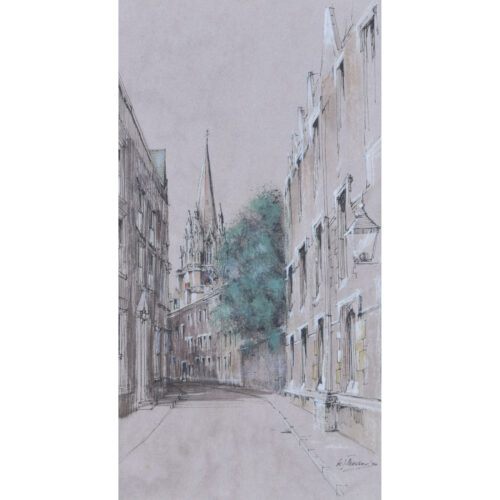
Ken Messer (1931 - 2018)
Oriel Street (1974)
Watercolour 39 x 21 cm Signed and dated lower right. The painter and draughtsman Ken Messer is closely related to Oxford and its architecture in several ways. Born in Newport, South Wales, he was educated at the City of Oxford High School for Boys in Oxford, and then spent six years working as an accountant in Oxford. He then joined British Overseas Airways Corporation (BOAC) as a steward, flying internationally. Injury due to a car accident during the 1960s meant that he joined the design department of Pergamon Press in Oxford at the age of 33. Six years later, he was appointed to the position of studio manager, in charge of art and design. In 1974, Messer left Pergamon Press to become a freelance graphic designer. He started painting more watercolours, becoming a full-time artist. During the 1980s, his ink drawings were regularly published in the Oxford Times. He has sometimes been called "The Oxford Artist" because of his large number of works depicting Oxford. He and his wife Dilys lived at first in Richmond upon Thames and then in Abingdon, just south of Oxford. Messer's work has been shown at the Mall Galleries for the annual exhibitions of the Royal Institute of Painters in Water Colours annual exhibitions. Condition: very good. If you are interested, please email info@manningfineart.co.uk or call us on 07929 749056. Click here for other views of Oxford. -
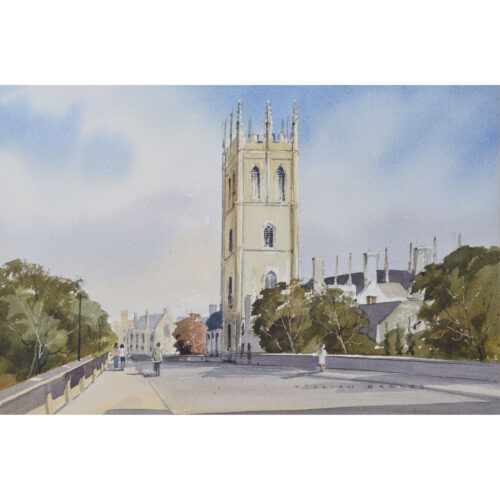
William Barnes (1916 - ?)
Magdalen Tower and Bridge
Watercolour 25 x 36 cm Signed lower right in ink. Magdalen Tower in all her glory, with pedestrians and a cyclist meandering over the bridge below. William Barnes was born in Brixton and trained at the Camberwell School of Art in the 1930s and the Wimbledon School of Art in the 1950s. Condition: good. If you are interested, please email info@manningfineart.co.uk or call us on 07929 749056. Click here for other views of Magdalen College, Oxford. -
Out of stock
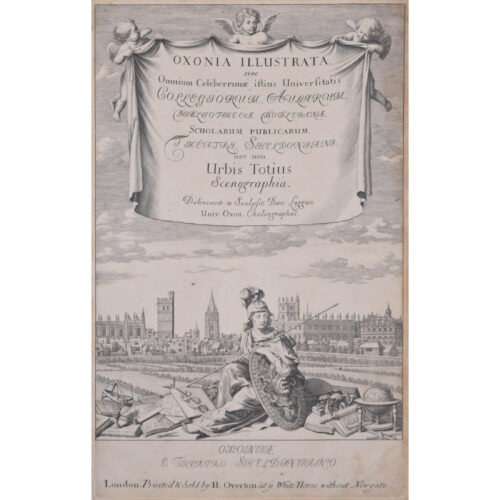
David Loggan (1634 - 1692)
Frontispiece to the Oxonia Illustrata (1675)
Engraving 38 x 24 cm The intricately engraved frontispiece to Loggan's 'Oxonia Illustrata', featuring cherubs bearing the volume's title on a banner and Minerva, goddess of wisdom, sitting before a panorama of Oxford's resplendent architecture. David Loggan's view of Oxford's medieval Divinity School, which was once the beating heart of theological studies at the University. Of particular interest here is the trompe l'oeil scroll of torn paper which frames the view. Loggan was born to English and Scottish parents, and was baptised in Danzig in 1634. After studying engraving in Danzig with Willem Hondius (1598-1652 or 1658), he moved to London in the late 1650s, going on to produce the engraved title-page for the folio 1662 Book of Common Prayer. He married in 1663 and moved to Nuffield in Oxfordshire in 1665. Loggan was appointed Public Sculptor to the nearby University of Oxford in the late 1660s, having been commissioned to produce bird’s-eye views of all the Oxford colleges. He lived in Holywell Street as he did this. The 'Oxonia Illustrata' was published in 1675, with the help of Robert White (1645-1704). Following its completion, Loggan began work on his equivalent work for Cambridge; the 'Cantabrigia Illustrata' was finally published in 1690, when he was made engraver to Cambridge University. The 'Oxonia Illustrata' also includes an engraving of Winchester College (Winchester and New College share William of Wykeham as their founder) whilst the 'Cantabrigia Illustrata' includes one of Eton College (which shares its founder, Henry VIII, with King’s College). Bird’s-eye views from this era required a particular talent as an architectural perspectivist; it was not until 1783 that it became possible for artists to ascend via hot air balloons and view the scenes they were depicting from above. Loggan thus had to rely on his imagination in conceiving the views. Loggan’s views constitute the first accurate depictions of the two Universities, in many ways unchanged today. Whilst the Oxford engravings were produced in reasonable numbers and ran to a second edition by Henry Overton (on thicker paper and with a plate number in Roman numerals in the bottom right-hand corner), those of Cambridge were printed in much smaller numbers. The Dutchman Pieter van der Aa published some miniature versions of the engravings for James Beverell’s guidebook to the UK, 'Les Delices de la Grande Bretagne' (circa 1708). The contemporary artist Andrew Ingamells (born 1956) has produced a highly-acclaimed series of etchings which bring Loggan’s original vision up to date. Condition: trimmed within platemark and mounted to board, otherwise in very good condition. If you are interested, please email info@manningfineart.co.uk or call us on 07929 749056. Click here for other general views of Oxford. -
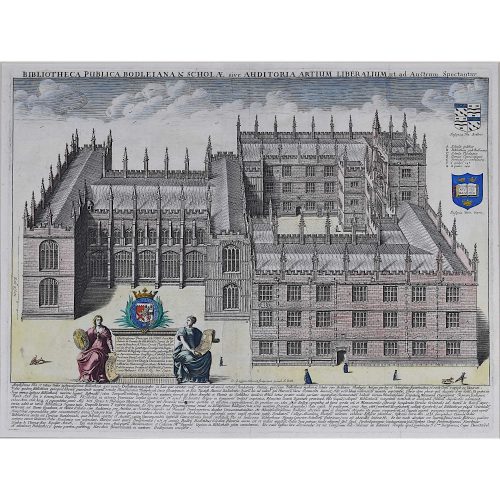
David Loggan (1634-1692) Bodleian Library Oxford - aerial view
Engraving (1675) with later hand colouring 30x40cm If you are interested email info@manningfineart.co.uk or call us on 07929 749056. -
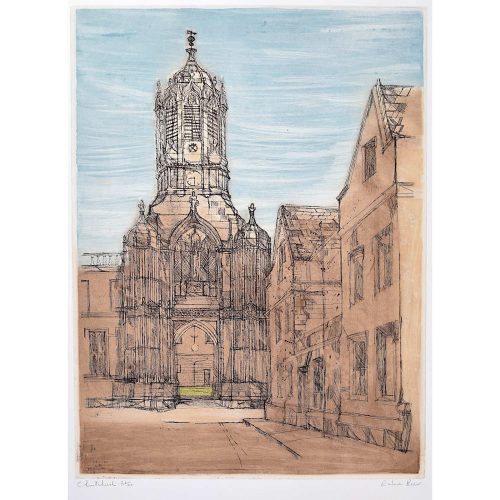
Richard Beer (1928-2017)
Christchurch, Oxford (1964-65)
Signed and titled, and numbered 24/100 Colour etching and aquatint on Velin Arches, published by Editions Alecto 64x48cm Click here for biography and other works by this artist. If you are interested email info@manningfineart.co.uk or call us on 07929 749056. -

Johannes 'Joan' Blaeu (1596 - 1673)
Oxonium Comitatus, Vulgo Oxfordshire (1662)
Engraving with later hand-colouring 38 x 50 cm A decorative map of Oxfordshire by the celebrated Dutch mapmaker and artist Joan Blaeu, (son of the cartographer Willem Blaeu). Two Oxford scholars flanks the cartouche which declares the map to be of Oxonium (that is, Oxfordshire), and the design also features the arms of the British Royal Family, King Alfred, and the University of Oxford. Sixteen colleges crests border the map. Blaeu moved to Amsterdam in 1920 to join the family firm of mapmakers. In 1635, the business published the Theatrum orbis terrarum, sive, Atlas novus in two volumes - the largest and most expensive book published in the seventeenth century, and the venture for which the Blaeu were most famed. Joan and his brother Cornelius took over the studio after their father died in 1638; Joan became the official cartographer for the Dutch East India Company, as his father had been before him. Condition: mostly very good; area of toning to top left where coloured to reverse. Good oak frame. Framed with reverse visible. If you are interested, please email info@manningfineart.co.uk or call us on 07929 749056. Click here for other antique maps. -
 Robert Tavener (1920-2004) Magdalen College, Oxford (artist’s proof) Signed Screenprint 69×48 cm (27.1×18.8 inches) Framed in a gilt frame Click here for biographical details and other works by the artist. If you are interested email info@manningfineart.co.uk or call us on 07929 749056.
Robert Tavener (1920-2004) Magdalen College, Oxford (artist’s proof) Signed Screenprint 69×48 cm (27.1×18.8 inches) Framed in a gilt frame Click here for biographical details and other works by the artist. If you are interested email info@manningfineart.co.uk or call us on 07929 749056. -
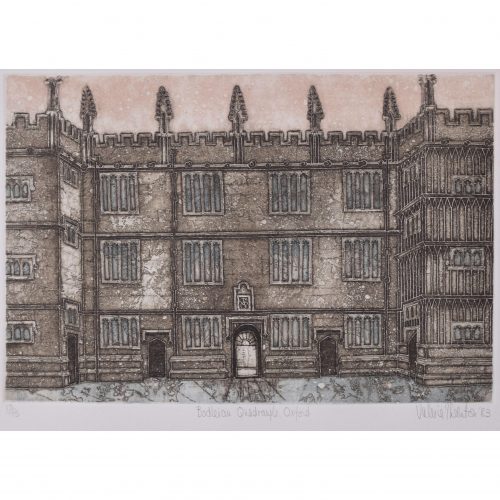
Valerie Thornton (1931-1991)
Bodleian Quadrangle, Oxford (1983)
Etching 24 x 35 cm Numbered 13/75 lower left, titled below, and signed and dated lower right, all in pencil. A very good example of Thornton's recognisable and unusual etching style. Her work is deeply concerned with material, and many of her etchings focus on eroded stone, emotive landscapes, and weathered architecture. Here, Thornton draws out the exceptional texture of the Bodleian Library's local stone. Valerie Thornton was a British etcher and printmaker. She was born in London, but was evacuated to Canada with her two brothers during World War II. She returned to London in 1944 and studied at the Byam Shaw School of Art in 1949. From 1950 to 1953 Thornton studied under P.F. Millard at the Regent Street Polytechnic, then spent eight months at Atelier 17 in Paris. In the early 1960s, she moved to New York and worked at Pratt Graphic Art Centre. In 1955, she succeeded Howard Hodgkin as assistant art teacher at Charterhouse School and in 1965 she became a founding member of the Print Makers Council. In 1970 she became a Fellow of the Royal Society of Painters-Etchers and Engravers. Thornton was a member of The Regent Street Group (a group of nine artists who studied together at the Regent Street Polytechnic in the early 1950s). The group also included Susan Horsfield, Renate Meyer, Michael Lewis, Ken Symonds, Philip Le Bas, and Peter Riches. Thornton's work is included in a number of major public collections including the Victoria and Albert Museum, the British Museum, and the Tate. Thornton died in 1991 in Chelsworth, Suffolk. Condition: generally very good. If you are interested, please email info@manningfineart.co.uk or call us on 07929 749056. Click here for more works by Valerie Thornton. -
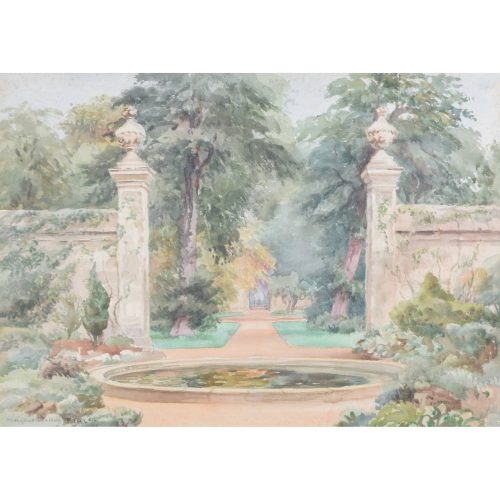
Margaret Waller (1916 - 1997)
The Oxford University Botanic Garden
Watercolour 35 x 51 cm Signed lower left. A watercolour depicting the serenity of Oxford's Botanic Garden. Koi swim just below the surface of the round pond and the garden stretches into the distance through a pair of stone arches. Margaret Waller was a mid-century artist and Fellow of the Institute of Arts and Letters. Condition: generally good; a little spotting to the sky. 'FIAL' added to signature later. If you are interested, please email info@manningfineart.co.uk or call us on 07929 749056. Click here for other non-collegiate views of Oxford. -
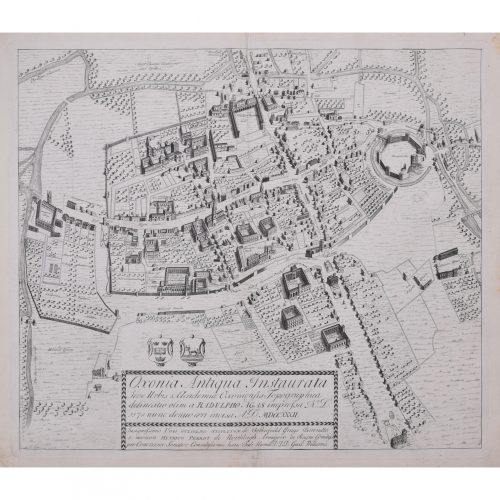
William Williams (Welsh, active 1724 - 1733)
The First Map of Oxford (1733)
Engraving 47 x 54 cm In 1578, Ralph Agas drew the first ever map of Oxford, studded with the first colleges of the University. In 1733 it was engraved by William Williams for publication in the Oxonia Depicta, a book of illustrations depicting similar views as David Loggan's volume of engravings. Ralph Agas was an English surveyor and cartographer. He was born in Suffolk and lived there throughout his life, although he travelled regularly to London. He began to practise as a surveyor in about 1566, and has been described as "one of the leaders of the emerging body of skilled land surveyors". regular work consisted of drawing up local estate maps and surveys for a variety of clients. He was one of the first estate surveyors to move beyond the traditional practice of compiling purely written descriptions of landed property, and to supplementing them with measured maps. Condition: generally very good; a few marks to margins. Central fold as issued. If you’d like to know more, please email info@manningfineart.co.uk or call us on 07929 749056. Click here for other general views of Oxford. -
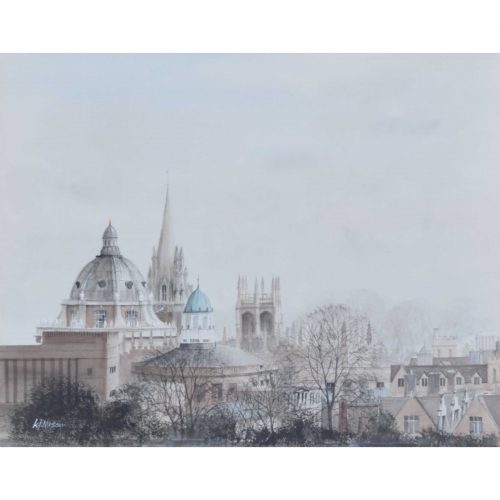
Ken Messer (1931 - 2018)
Dreaming Spires
Watercolour 30 x 38 cm Signed lower left. Oxford's skyline, including the Radcliffe Camera, the spire of University Church of St Mary the Virgin, and Magdalen Tower, is silhouetted against the grey sky of a winter day. The trees in the foreground are stark and black. Messer's depiction of Oxford's dreaming spires is an outstanding architectural record of the city's - and University's - most remarkable buildings. The painter and draughtsman Ken Messer is closely related to Oxford and its architecture in several ways. Born in Newport, South Wales, he was educated at the City of Oxford High School for Boys in Oxford, and then spent six years working as an accountant in Oxford. He then joined British Overseas Airways Corporation (BOAC) as a steward, flying internationally. Injury due to a car accident during the 1960s meant that he joined the design department of Pergamon Press in Oxford at the age of 33. Six years later, he was appointed to the position of studio manager, in charge of art and design. In 1974, Messer left Pergamon Press to become a freelance graphic designer. He started painting more watercolours, becoming a full-time artist. During the 1980s, his ink drawings were regularly published in the Oxford Times. He has sometimes been called "The Oxford Artist" because of his large number of works depicting Oxford. He and his wife Dilys lived at first in Richmond upon Thames and then in Abingdon, just south of Oxford. Messer's work has been shown at the Mall Galleries for the annual exhibitions of the Royal Institute of Painters in Water Colours annual exhibitions. Condition: excellent. If you’d like to know more, please email info@manningfineart.co.uk or call us on 07929 749056. -
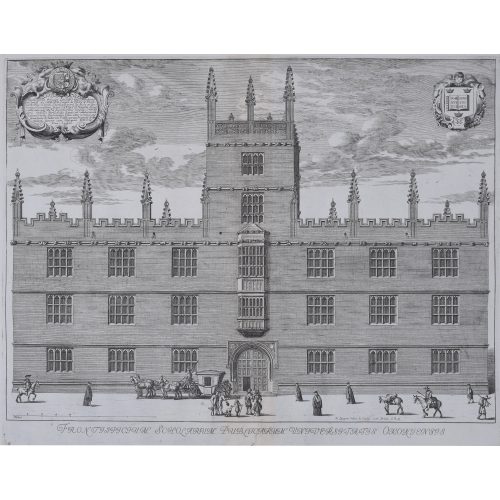
David Loggan (1634-1692)
Frontispiece Public Schools Oxford
Engraving 33x42cm If you are interested email info@manningfineart.co.uk or call us on 07929 749056. -
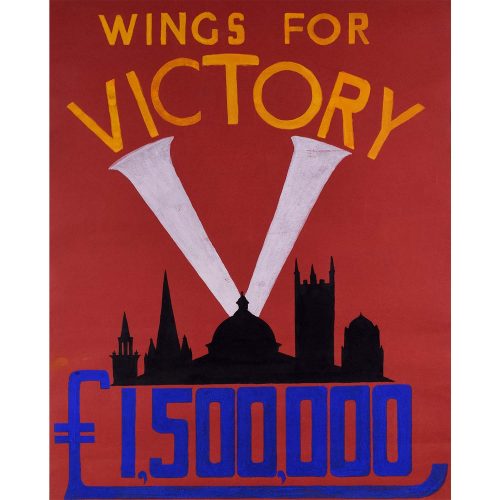
Anonymous
Oxford Wings for Victory Poster Design II
c.1943 Gouache on paper 63 x 50 cm 81x66cm including hand-finished frame, UK shipping only Click here to see other posters from this series. If you are interested email info@manningfineart.co.uk or call us on 07929 749056. Condition: Excellent. -
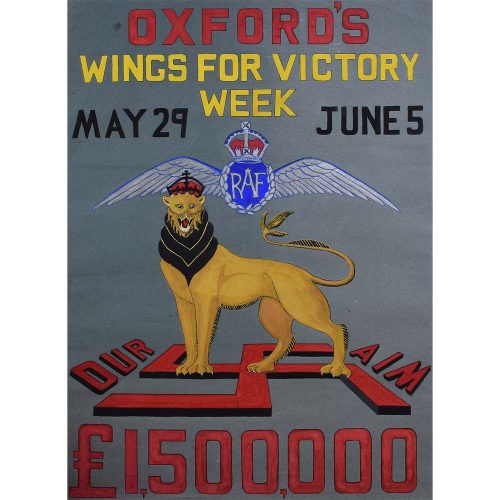
Anonymous
Oxford Wings for Victory Poster Design IV
c.1943 Gouache on paper 70 x 51 cm 89 x 68 cm including hand-finished frame, UK shipping only Click here to see other posters from this series. If you are interested email info@manningfineart.co.uk or call us on 07929 749056. Condition: Excellent.

